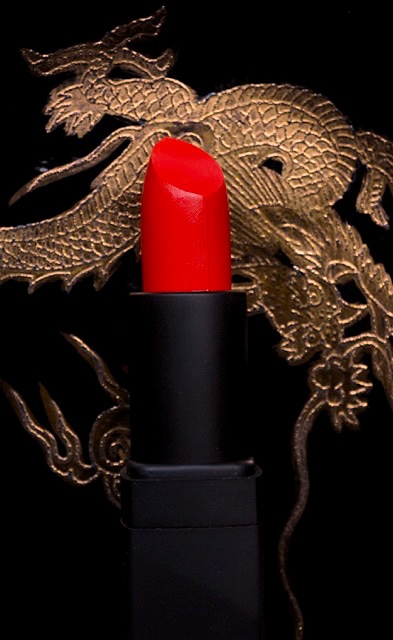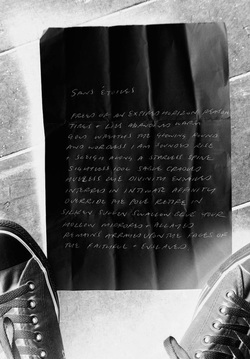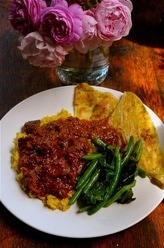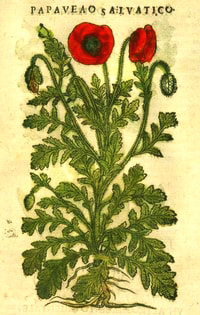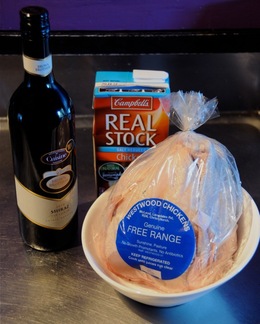
This is a medium sized chicken. I've found they all take around the same time to cook so don't freak about the kilos unless you have some weeny little pullet or hulking mutant on your hands. In that case, just go up or down 20 minutes on either end of the time scale. It's done when it's done.
Another thing you should know is that free-range birds are probably not going to be as 'tender' as you might expect after eating greasy tween chickens that were too fat to stand up, especially when frozen. FR birds can move around and have a life, and really, that's the only kind of animal we should ever be eating. (More about that in my responsible carnivore post.) But they are tastier, leaner, less pathological and much better karma, so we should just quit our whining and be grateful we have access to meat at all. We usually cook them 'wet' in a curry or sauce but, properly handled, they are still perfectly delicious on their lonesome.
Today we'll do a solo roast chicken with home made pan gravy. Nothing terribly exotic but a universal pleasure none the less.
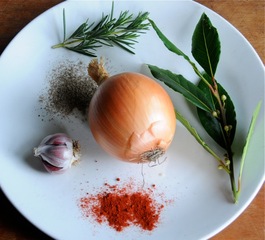
1 free range chicken
Good smoked paprika
Small head of spray-free garlic
Freshly ground pepper
Fresh rosemary sprig (you can substitute dried)
Fresh bay spring (ditto)
Ordinary onion
Jam (I use my own quince jelly and elderberry ink but anything mellow and fruity like apricot, cranberry or blackberry is perfect.)
Stock (we usually have our own stock made from the frames of our previous roast chickens but it's supermarket shiz today.)
Wine. Use whatever you like best, red or white. Cheap stuff is fine, but if you really wouldn't drink it from a glass, don't expect stellar results.
You'll also need the cooking oil of your choice; today we'll be using a half-half olive and rice oil mix, but you can throw in some fat left over from your last roast or butter.
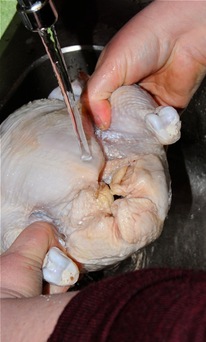
Make sure you rinse the chicken thoroughly under cold water. Be particularly assiduous about rinsing and examining both the neck scrag and inside the carcass through the vent; sometimes suppliers provide you with giblets (usually the liver, neck, heart and gizzard) and these can be tucked away inside the cavity, where they go unnoticed until the plastic bag they're packed in starts oozing in a molten fashion from your chicken as you go to carve the little sucker. Suboptimal. Don't be afraid of giblets. They're not weird or gross; we all have them. They can be fried and used to make a superlative stock for the gravy; sadly, we have none to show you today.
Have a ferret around inside the cavity just to make sure there's nothing hiding in there. Stick your hand right in there. (Is it Friday night already? Lol, yes I stole that from The Usual Suspects). If you find your chicken is still a little stiff and frozen inside, run some cool or just-warm water into the cavity and let stand for five mins; if there's still detectably frozen flesh, you'll just have to thaw it for longer. Try to resist the temptation to microfuck it unless you're really running out of time. Wash your hands with soap after handling raw chicken and thoroughly wash down the taps, sink and benches.
(If you suspect you have a really elderly, stringy old chook on your hands, do not despair. There is a way to salvage that beast that hasn't failed me yet and I use it regularly with Christmas turkeys; subcutaneous basting. Cut yourself some four thin pats of cold butter. Take a tablespoon, turn it upside down and ease it under the skin of the breast, starting from the vent and then heading sideways over each drumstick. You'll see how this works once you've begun. Into this loosened, 'tented' skin, push the pats of butter until you've situated two over the breast and one each over the legs. They will melt as cooking proceeds.)
| So here it is, ready to go into the oven. Use a flat-bottomed enameled or metal pan like this if you have one, since we'll be making the gravy on the stove top and it needs to be able to stand the heat and provide a decent surface area. The liquid you see on the floor of the pan is about 3/4 of a cup of water; you can use stock but I find it can blacken and stick to the enamel, and this isn't really what you want. |
I'm not sure if it makes perfect thermodynamic sense, but the water seems to prevent the bird from drying out too much; that may just be superstition on my part. I'm more convinced that a moist roast is dependent on the condition of the bird before it died and how it was treated post-mortem, but who the hell knows? Just don't add too much liquid or you'll get chicken soup. If you're really concerned about your own chicken-munting propensities, there is a way to cheat and cut the cooking time by about a third- cut the chicken all the way along the backbone with kitchen scissors and spread it out flat in the pan. Arranged this way it will cook thoroughly in about an hour but won't really look as pretty or traditional.
Mmokay, so put the dish on the lowest rack of the oven and let it cook at 180 degrees C for about ten minutes, then turn it down toward 160-150 C for around an hour and 15 mins for an unstuffed bird like this. Wait til some of the water has evaporated before basting from the dish or you'll just end up washing the seasonings off the skin.
| Here it is after about an hour. Looks cooked, doesn't it? It's not, though. See the cloudy stuff in the pan between the chicken and the garlic head? That's the blood from the neck and cavity; it turns a greyish opaque brown on hitting the hot fat. It forms the base of the gravy so leave it there, but if it's still running out all pink and liquid when you tilt the bird, it's not finished. Baste the chicken and the onions and put it back on for another 10-15 mins at 150 C, then have another look. When your bird's cooked, put it aside under a lid or foil to rest for at least 20 minutes. |
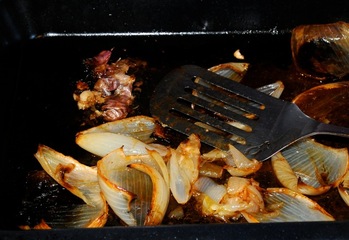
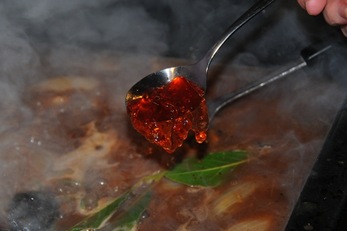


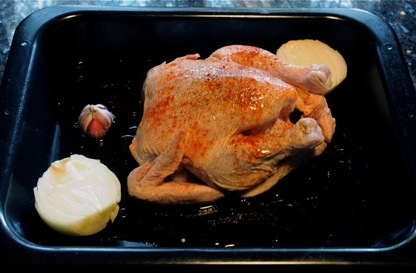
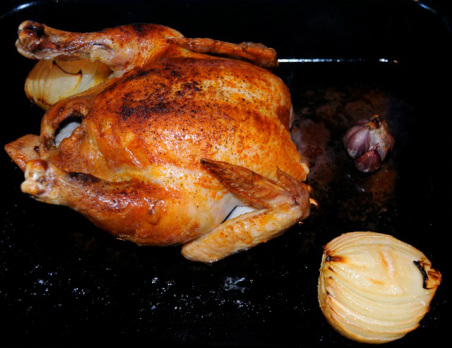
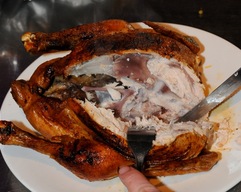

 RSS Feed
RSS Feed






